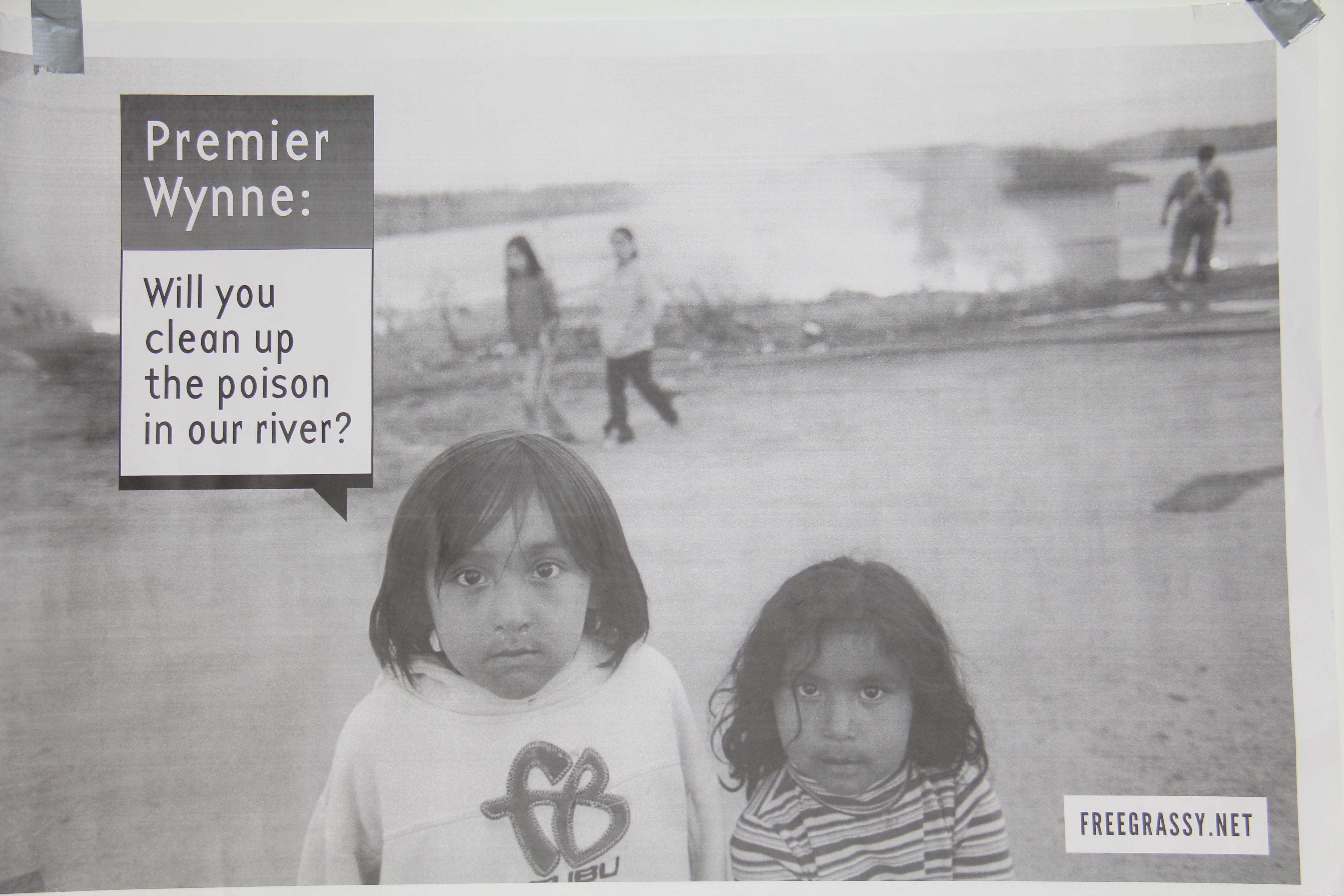Like this article? rabble is reader-supported journalism. Chip in to keep stories like these coming.
This week, a new study commissioned by the Ontario provincial government and the Grassy Narrows First Nation determined that the mercury poisoning of the Wabigoon-English River system can be cleaned up.
Grassy Narrows (Asabiinyashkosiwagong Nitam-Anishinaabeg) community members are in Toronto demanding environmental justice from the premier.
Chief Simon Fobister Sr. acknowledged the challenges still faced after decades of mercury activism, calling for Kathleen Wynne to act on the report.
“We need to send a message to her that we want this river cleaned up, and not only would it help us, but future generations,” said Fobister in a forum with community elders, Grassy Narrows youth, and environmentalist Avi Lewis.
On Thursday, activists, community members and allies will descend on Queen’s Park for River Run 2016. This biennial rally is dedicated to raising awareness and inciting government action on the ongoing effects of mercury poisoning in the northwestern Ontario river system.
The persisting effects of the Dryden pulp mill dump between 1962 and 1970 combined with subsequent clearcutting, have maintained levels of toxicity in water and fish creating severe health conditions for affected communities.
The talk, hosted at Ryerson University, took place the day after the premier, in response to the Truth and Reconciliation Commission, issued a formal apology for the abuse and intergenerational trauma suffered as a result of the residential school system.
Later that day, the premier dismissed the newly released study’s origin.
“I don’t know the source of the report where I understand there is some suggestion that there is still new mercury that is leaking,” Wynne said at Queen’s Park on Monday, according to KenoraOnline.
“I don’t know the source of that, I look forward to looking at the report. But rest assured that we are very much engaged, even before this report came, on trying to make sure people in Grassy Narrows have clean water and a clean environment.”
Avi Lewis, who called the ongoing contamination “a crime in progress,” doesn’t buy Wynne’s response.
“She said she hadn’t seen the study,” said Lewis. “Her government paid for it, and she personally established the working group that commissioned it!”
A spokesperson for the Ministry of Environment and Climate Change in Ontario later told the CBC “we understand and are sympathetic to the concerns raised,” however, no commitment to cleaning up the mercury has been made.
Lewis emphasized the links between legacies of colonization, ongoing environmental abuse and systemic injustice.
“Every day that goes by without justice for Grassy Narrows is another attack on the land, and the animals, and the people that protect them day after day, decade after decade,” he said.
“Just like the attacks of colonialism continue from genocide that founded this country, to its continuation in residential schools, to all the missing and murdered Indigenous women — those attacks continue every single day that justice is delayed and denied.”
The interim strategy for dealing with contamination in Grassy Narrows has been “natural recovery,” a method roundly debunked in the new study.
“We do not consider MNR (Monitored Natural Recovery) to be a viable standalone option for the Wabigoon-English System because fish mercury concentrations in Clay Lake are presently not declining or are declining at an imperceptible rate,” wrote its authors.
After 50 years of Grassy Narrows’ relentless activism, Clan Mother, Judy Da Silva, who won the Michael Sattler peace prize in 2013 for nonviolent resistance, said she’s encouraged by the tenacity of her community’s youth.
“Some of our people don’t know how to fight back or how to speak back because of intergenerational trauma from residential schools,” she said.
“But here they are today. They came on that bus — two days ride together — and that’s the kind of resilience our people had. And I want to stop saying we’re victims because we’re not victims.
“We are like a strong powerful people. And that’s what the government has to look at, is that we’re not going to give up,” said Da Silva.
The forum was punctuated with a performance by Grassy Narrows youth.
“Home to Me,” a song (and music video) created with the N’We Jinan collective, captures ideas of environmental justice, connection to land, love and hope with transcendent courage.
Their determination and preceding generations of activism make Lewis optimistic that change is impending.
“I thought the ground started to move today,” he said.
“I think the extraordinary work of generations of Grassy Narrows activists is starting to pay off.”
Anishnawbe-kwe writer, curator, community organizer and the event’s master of ceremony Wanda Nanibush encouraged talk attendees to bring out friends and family to Thursday’s rally. She also noted that, at the time of Tuesday’s event, 2,000 signatures were signed to a petition calling for the premier and Prime Minister Justin Trudeau to clean up Grass Narrows’ river, discontinue logging, and provide “state of the art care for mercury survivors.”
“What we’re doing is a gesture of love,” said Nanibush.
As of Wednesday morning, more than 3,000 people have signed the petition.
Learn more about the Grassy Narrows River Run happening tomorrow June 2.
Editor’s note: An earlier version of this piece said the Ontario government and Grassy Narrows First Nation had “funded” the study when they had “commissioned” the study. rabble regrets the error.
Steph Wechsler is a freelance writer and master’s candidate at the Ryerson School of Journalism.
Photo: Steph Wechsler



